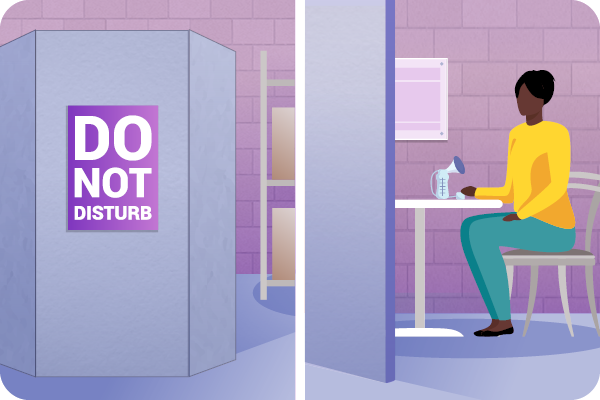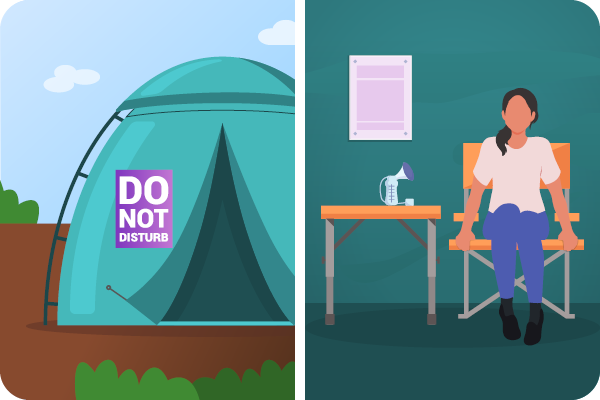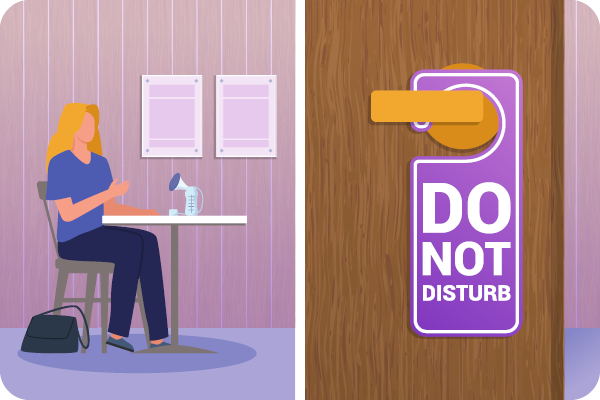Fact Sheet #73A: Space Requirements for Employees to Pump Breast Milk at Work under the FLSA
March 2025
Under the Fair Labor Standards Act (FLSA), as amended by the Providing Urgent Maternal Protections for Nursing Mothers Act (the PUMP Act), most nursing employees have the right to reasonable break time and a private place to pump breast milk while at work. This right is available each time the employee needs to pump for up to one year after the child's birth.
This Fact Sheet summarizes the space requirements for pump breaks under the FLSA.
ABOUT THE FLSA
The FLSA establishes minimum wage, overtime pay, recordkeeping, and child labor standards affecting full-time and part-time employees in the private sector and in federal, state, and local governments. The FLSA also protects the rights of employees to pump breast milk at work.
For more information about the FLSA, visit www.dol.gov/agencies/whd/flsa.
Nearly all FLSA-covered employees, including employees who telework, have the right to take needed time and to access a private space to express breast milk. This right is available for up to one year after the child's birth. An employer may not deny a covered employee a needed break to pump.
For more information about FLSA protections to pump at work, including certain limited exemptions from the requirement, see Fact Sheet #73.
SPACE REQUIREMENTS
The FLSA requires employers to provide nursing employees a place to pump while at work that is:
- Shielded from view,
- Free from intrusion from coworkers and the public, and
- Not a bathroom.
The space must be:
- Functional for expressing breast milk and
- Available whenever a nursing employee needs to pump.
Additionally, an employee must be able to safely store breast milk. While employers are not required to provide a refrigerator, they must allow a nursing employee to bring a pump and insulated food container or personal cooler to work and ensure there is a place for the employee to store these items while working.
SHIELDED FROM VIEW AND FREE FROM INTRUSION

The employer must ensure that all nursing employees, including employees who telework, are shielded from view and free from intrusion when pumping. This includes being shielded from the view of and free from intrusion by members of the public and co-workers, including any co-workers who are also pumping. An employee must also be free from observation by any employer-provided or required video system, including a computer camera, security camera, or web conferencing platform, when she is expressing breast milk, regardless of her location.
To ensure privacy, employers may provide barriers to shield the nursing employee from view and keep the area free from intrusion. For example, employers may:
- Provide a space with a locking door or use of a sign that designates when the space is in use and off limits to others,
- Create a temporary space for pumping by providing dividers and signs in a portion of a vacant office or storage room, or
- Allow the employee to use a manager's office or conference room that has a door, with a lock or appropriate signs to prevent intrusion, provided the space is available each time the employee needs to pump.
Employers must also block or turn off cameras and recording devices during the employee's pump break.
BATHROOMS ARE PROHIBITED
A bathroom, even if private, is not a permissible location for the employer to provide for pumping breast milk. Nursing employees must be provided a space to express breast milk in a clean and private environment.
FUNCTIONAL SPACE FOR EXPRESSING BREAST MILK
Any location that an employer provides must be functional as a space for pumping. The space must contain a place for the nursing employee to sit, and a flat surface, other than the floor, on which to place the pump.
Ideally, spaces to pump breast milk should also include access to electricity, allowing a nursing employee to plug in an electric pump rather than use a pump with battery power, which may require more time for pumping. Additionally, access to a sink near the space provided to pump so that an employee can wash her hands and clean attachments improves the functionality of the space to pump breast milk at work.
Examples:
Merin, a logging company employee, uses a shielded office break room for pumping, with the door locked for privacy.

Yesenia, a farmworker, uses a temporary pumping space created by her employer in a pop-up tent. The tent is large enough for a chair and a table for the pump, and tall enough for her to stand up in.

The WHD protections to pump at work -- door hanger and pump at work flyers are available at www.dol.gov/agencies/whd/pump-at-work.
AVAILABLE WHEN NEEDED
An employer must make sure space is available each time an employee needs to pump. However, it is not required that employers create permanent, dedicated spaces for employee pump breaks. A space for pumping may be mobile or temporary. A space temporarily created or converted into a space for expressing breast milk or made available when needed by the nursing employee is sufficient provided that the space is shielded from view and free from any intrusion from co-workers and the public.
Employers should take into consideration the number of nursing employees, their work locations, and their work schedules to determine whether more than one space should be designated or created and where such space should be located. For instance, some employers may choose to provide a dedicated room for pumping on each floor of a large facility. Other employers may choose to provide a shared space, such as a large room with privacy screens between employees, which may be used by multiple employees simultaneously to pump, as long as the privacy of each employee is ensured.
The employer must ensure that the designated space is not so far from the employee's work area as to make it impractical for the employee to take breaks to pump. The employer must also ensure that the number of nursing employees needing to use the space does not prevent an employee from taking pump breaks or result in prolonged waiting time.
ADDITIONAL PROTECTIONS
Protection from Retaliation
The FLSA is a federal worker protection law. Employers are prohibited from interfering with, restraining, or denying the exercise of, or the attempt to exercise, any FLSA right, including the right to pump at work. For more information about prohibited employer retaliation under the FLSA, see Fact Sheet 77A and Field Assistance Bulletin 2022-2.
Retaliation occurs when an employer (through a manager, supervisor, administrator or directly) fires an employee or takes any other type of adverse action against an employee for engaging in a protected activity.
Example:
Neveah complained to a supervisor that there was no chair in the room she was to use for pump breaks. The supervisor told Neveah to borrow a chair from a coworker. When Neveah objected, the supervisor accused Neveah of being insubordinate and gave her a written reprimand.
In this example, Neveah was disciplined for attempting to exercise her rights, which is retaliation by the employer and an FLSA violation.
Enforcement
An employee may file a complaint with the Wage and Hour Division or may file a private cause of action seeking appropriate remedies. Remedies may include employment, reinstatement, promotion, and the payment of wages lost and an additional equal amount as liquidated damages, compensatory damages and make-whole relief, such as economic losses that resulted from violations, and punitive damages where appropriate. These remedies are available regardless of whether the employee has also experienced retaliation.
If an employee chooses to file a private action regarding her employer's failure to provide an appropriate space to pump, the employee may be required to provide her employer notice of the failure and 10 days to come into compliance. The employee is not required to provide notice, however, before filing a complaint with the Wage and Hour Division or when filing a private action for her employer's failure to provide reasonable break time. These special procedures do not apply if the employee was fired in retaliation, or the employer refused to comply.
Other Laws
Nothing in the FLSA prevents employees from receiving protections under other laws. Workers have the right to benefit from all the laws that apply.
Many states and localities have their own worker protection laws. For more information about the laws in your area, you may wish to contact your State Labor Office.
The U.S. Equal Enforcement Opportunity Commission (EEOC) enforces federal laws that prohibit workplace discrimination, including the Pregnant Workers Fairness Act (PWFA), Title VII of the Civil Rights Act of 1964 (Title VII) and the Pregnancy Discrimination Act, the Equal Pay Act of 1963 (EPA), and Title I of the American with Disabilities Act (ADA).
The Family and Medical Leave Act (FMLA) provides eligible employees of covered employers with job-protected leave for qualifying family and medical reasons and requires continuation of their group health benefits under the same conditions as if they had not taken leave. For more information about the FMLA, visit www.dol.gov/agencies/whd/fmla.

Where to Obtain Additional Information
For additional information, visit our Wage and Hour Division Website: http://www.dol.gov/agencies/whd and/or call our toll-free information and helpline, available 8 a.m. to 5 p.m. in your time zone, 1-866-4USWAGE (1-866-487-9243).
This publication is for general information and is not to be considered in the same light as official statements of position contained in the regulations.
